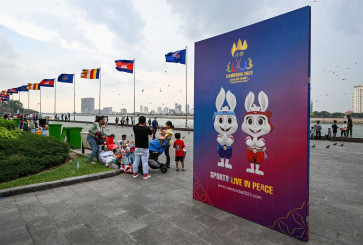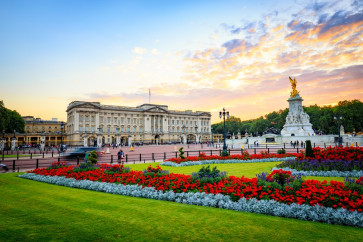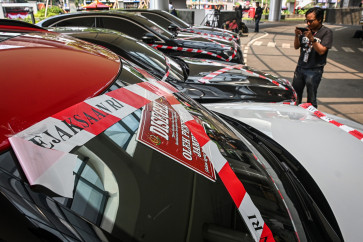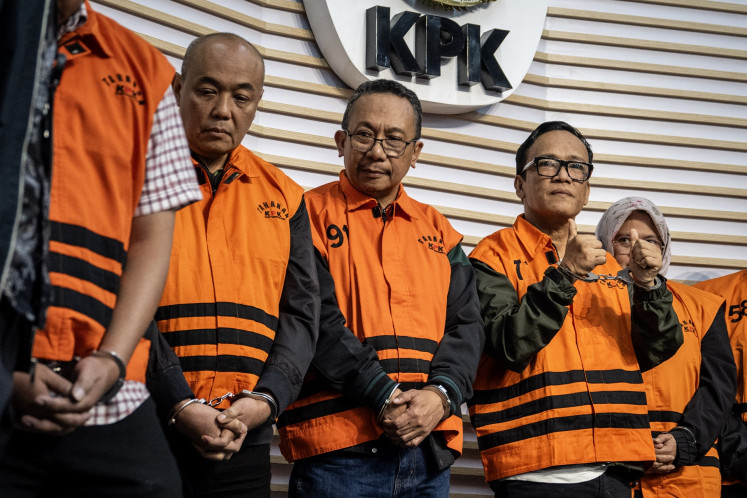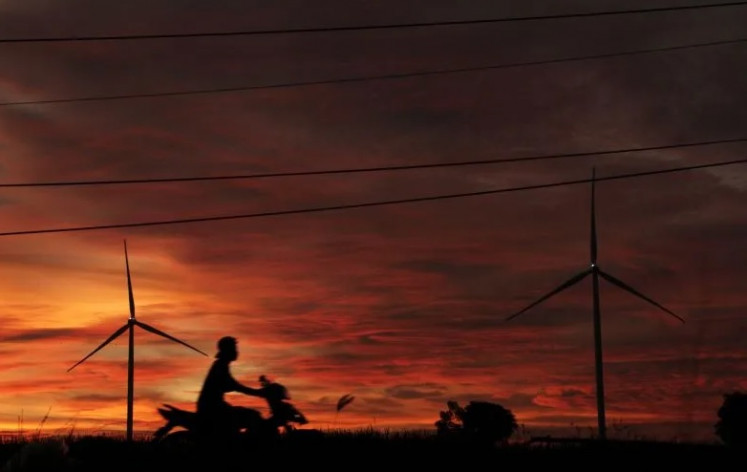Popular Reads
Top Results
Can't find what you're looking for?
View all search resultsPopular Reads
Top Results
Can't find what you're looking for?
View all search resultsLearning from Japan’s transportation system
Supporting facility: The landscape of Minato Mirai, a transit-oriented development (TOD) area, was built on top of reclaimed land in Yokohama, Kanagawa
Change text size
Gift Premium Articles
to Anyone
S
upporting facility: The landscape of Minato Mirai, a transit-oriented development (TOD) area, was built on top of reclaimed land in Yokohama, Kanagawa. Minato Mirai was developed in the 1980s to optimize Yokohama’s role as one of Japan’s port cities. (JP/Vela Andapita)
Japan is a global car manufacturing giant. Yet, the country is pedestrian and public transportation friendly, with mass transportation services — mostly railway-based — making it easy for all to travel within Japan. The Jakarta Post’s Vela Andapita was among a number of Indonesian journalists who recently visited Japan under a fellowship program by PT MRT Jakarta to learn about Japan’s mass transportation system. Her notes on the program have been transcribed for today’s Special Report.
It was a regular busy weekday morning at Shinjuku Station in Tokyo. At 8:00 a.m., people wearing typical “salaryman” clothes were rushing to catch their trains or exiting stations to reach their offices at nearby buildings.
Among them was a group of Indonesian tourists that attempted to squeeze themselves into a packed train car on the Yamanote line. Yamanote is a loop line that connects Shinjuku with some other big stations, like Tokyo, Ueno, Shinagawa and Shibuya stations.
Of the nine people in the group, only five managed to enter the train. The remaining four had no choice but to step back, hoping that the next train would come soon so that they would not be separated for too long.
To the relief of the tourists, less than two minutes later, another train approached.
“The shortest headway is one minute and 50 seconds,” Japan International Cooperation Agency (JICA) transportation expert Hideaki Tanaka told the visiting Indonesian journalists in Tokyo.
“There are around 600 train stations throughout Tokyo. Each of them stands within walking distance. Wherever you are in the city, you can find an entrance to a train station within five minutes of walking.”
Japan’s railway transit history dates back to the end of the Edo or Tokugawa era and the beginning of the Meiji Restoration in the late 1860s. In 1920, Tokyo Underground Railway Company was founded and it began to construct a subway system.
The system grew rapidly in the 1960s following the 1964 Tokyo Summer Olympics. In 1975, the number of train passengers exceeded the service’s maximum passenger load factor, with a congestion rate of 221 percent.
Tokyo’s provincial and municipal administrations worked hard to add more trains and build more railways and stations. In 2018, the congestion rate decreased to 160 percent — all seats were occupied yet the standing passengers were able to move about the train or even open up a newspaper.
Tanaka said people in Tokyo had been accustomed to commuting by train for decades because it was the most reliable means of transportation when compared with road-based modes of transportation, like the bus, taxi or private car.
“We prefer walking and enjoying the packed train instead of owning a car that would cost us a fortune with its expenses. The car tax and the parking fees are pretty expensive,” he laughed.
According to 2014 data from the Japanese Land, Infrastructure, Transport and Tourism Ministry, there were 2,479 kilometers of rail tracks in Tokyo, 1,214 km of which were privately owned by 28 train operators, while another 887 km were owned by the East Japan Railway (JR East) Group, which was initially a state-owned company but has since then been privatized; additionally, some 358 km were served by a subway service and 17 km by a tram service.
Of the 358-kilometer subway line, 195.1 km were developed and operated by Tokyo Metro. According to 2018 data, Tokyo Metro alone operated 179 stations and had 2,719 train cars, serving an average of 7.58 million passengers on a daily basis.
The huge number of passengers made the company’s business so healthy that, according to Tokyo Metro director of international relations Naoto Kimura, 85 percent of its revenue was from either fare box or ticket sales. Only 15 percent came from its non-fare box businesses, such as from advertisements or space rent for retailers. Tokyo Metro’s net sales in 2018 reached US$3.6 billion.
Given that Tokyo city was already packed with stations and rail tracks, Kimura said, the city no longer needed more of them. Hence, when asked about how the company planned to develop its business, Kimura said, “What’s left to do is to support other countries to develop their railway systems.”
In Indonesia, particularly in Greater Jakarta, the urban train business has three players: a commuter line by PT Kereta Commuter Indonesia (KCI) — subsidiary of state-owned PT Kereta Api Indonesia (KAI), the MRT by city-owned PT MRT Jakarta and the light rapid transit (LRT) by PT LRT Jakarta, a subsidiary of city-owned construction firm PT Jakarta Propertindo (Jakpro).
While the commuter line started its service in 2009, the MRT and the LRT just kicked off their operations in 2019.
The commuter line has a total of 418.5 km of railways and 79 stations throughout Greater Jakarta. Toward the end of 2019, it began serving around 1 million passengers per day.
The MRT’s first phase line stretches some 16 km with 13 stations from Lebak Bulus in South Jakarta to the Hotel Indonesia traffic circle in Central Jakarta. The LRT’s first line, meanwhile, is 5.8 km between Kelapa Gading in North Jakarta and Rawamangun in East Jakarta.
The two companies are set to commence the construction of their respective second lines. Adding to that, soon the agglomerated cities will welcome LRT Jabodebek (Greater Jakarta LRT), developed by PT KAI. The service will connect Cawang in East Jakarta with Bekasi in West Java.
Earlier in November, head of the Greater Jakarta Transportation Agency (BPTJ) Bambang Prihartono said that railway-based transit modes should be the future of urban transportation. Building more roads in a car-loving city like Jakarta would only mean giving more space for people to use private cars, worsening traffic congestion.
Self service: A man puts his bicycle onto the Eco Cycle, an automated underground bicycle parking facility, near Shinagawa Station in Tokyo. For people in Tokyo, bicycles are the most common first- and last-kilometer vehicles before switching to and from trains. (JP/Vela Andapita)
Integrated system
As part of its public service, Japan has long been developing its integration system, including with supporting facilities that allow people to connect to different modes of transportation.
In Shinagawa Station, also in Tokyo, for instance, one can observe people interacting with a machine that looks like an elevator on a sidewalk. The machine is called Eco Cycle, an automated bicycle storage system.
To use it, a passenger taps their e-money card on a card reader, activating a loading mechanism. A door on the machine will open and pull in the bicycle, storing it in a 10-meter underground vault full of other tightly stacked bicycles.
“I usually park my bike here and walk to the station to take the train,” one passenger told The Jakarta Post right before leaving.
Tokyo’s park and ride bicycle system makes use of limited space, though it does not require a great deal of space to begin with given it is specifically for bicycles and was built underground.
Speaking of park and ride systems, Indonesia could use more of them, particularly in Jakarta and its satellite cities. Such a system could be specialized for cars and motorcycles and it could built upward instead of going underground if necessary.
A park and ride facility supporting the MRT in Jakarta is located 15 minutes by foot from Lebak Bulus Station. The area can accommodate up to 150 cars and 500 motorcycles.
A similar facility is available for commuter line passengers traveling from Bogor, Depok and Bekasi. It charges vehicle owners Rp 5,000 (36 US cents) per day for cars and Rp 2,000 for motorcycles.
The Jakarta Transportation Agency will add more park and ride areas next year in the city’s outskirts in a bid to reduce the number of private vehicles entering the capital.
Pointing to the city’s spatial plan, MRT president director William Sabandar said he had called on private companies, particularly the ones that owned buildings along MRT tracks, to cooperate in the establishment of such park and ride facilities.
Food for thought
Tokyo and Jakarta have several things in common. Both have a population of approximately 11 million, expanding to over 30 million when adding in satellite cities. While Greater Tokyo includes Omiya, Chiba and Yokohama as its satellite cities, Greater Jakarta includes Bekasi, Bogor, Depok and Tangerang.
One underlying difference is that, for years, society in Tokyo has grown alongside the development of its train service. The longstanding service, coupled with a high vehicle tax and high parking fees, has made railway-based transportation an irresistible option for the Japanese people.
Meanwhile, Jakartans are closely attached to their cars and motorcycles, so much so that even the idea of giving up more space for better pedestrian areas sparks public debate.
Another difference is that, in Japan, ideas for improvements in the transportation system — such as the integration of fare payment and train operating systems, and the construction of transit-oriented development areas — have mostly come from the private sector.
Meanwhile, improvements in Indonesia, including Jakarta, mostly rely on the government’s initiative, causing development, including in transportation, to move at a much slower pace.



